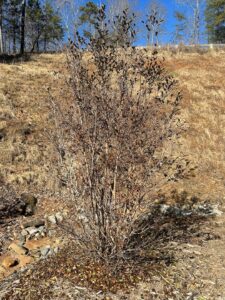By Mathew Parks
POA Grounds & Landscape Manager
The polar vortex that ripped through Big Canoe in late December gave us a Christmas most will not soon forget.
The sustained single-digit temperatures made not only humans uncomfortable but plants as well. With the speedy drop to single-digit
Hellebore at the Chimneys area too a beating this winter.
temperatures and the persistent cold, freezing damage is inevitable. It does not take long when traveling around Big Canoe to see the effects of the weather in wax myrtle, hellebores, camelias, blue-eyed grass and azaleas. The amount of damage is not easily known, but we will become more aware of its extent over the next few months.
Exposed locations and plants with marginal cold hardiness have received the bulk of the damage. Shrubs and groundcover along walkways and walls in south-facing areas seemed to fair better than north-facing plantings due to those areas warming up quicker. Unfortunately, north-facing plants were frozen for a much longer period of time.
Look for splits or cracks in the main stems of damaged plants and prepare to cut back below the damage. Gently scrape the branches until green is found. Bud development and leaf flush in the spring will indicate the severity and the amount of cutback needed. However, the University of Georgia Extension Agency has suggested a wait-and-see approach, so immediate pruning is not recommended. Although unsightly, the damaged stems and leaves can act as a blanket for the plant’s interior and help protect it from further freeze damage. I have noticed evergreen shrubs such as azalea and camellia took a major hit that caused leaf burn and even completed defoliation. Only time will tell.
This George Tabor azalea by the Marina parking area was also affected by the extreme cold.
Trees can suffer damage as well. The majority of trees in this area are deciduous, meaning they lose their leaves in the winter and grow new ones in the spring. At this time of the year, it is hard to determine the extent of the damage. Once the leaf flush occurs, homeowners will be able to assess the state of the plants. Canopy density, seed/fruit production, and pollination could be reduced this year. Due to the extremely low temperatures, trees may be damaged from frost pruning, a phenomenon that occurs mainly in the northern part of the U.S and affects new stems. The tips of the trees will die back and regenerate from there.
For future plantings, I recommend selecting plant material that is known to be hardy in this area. Native plant material such as mountain laurel, buckeye, florida and yellow anise, rhododendron, hemlock, and inkberry all seem to be unfazed by the cold weather we experienced. Another good reason to go native! After this winter, I’m sure the professionals at all of the local nurseries will be well versed on plant selection and recommendations for your yard.
For further reading, check out the University of Georgia’s article on the effects of low temperatures on plants.
The post How to Deal With and Prepare Against Plant Damage From Winter Weather appeared first on Inside the Gates.
